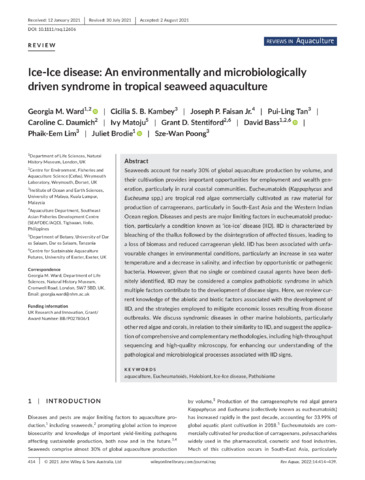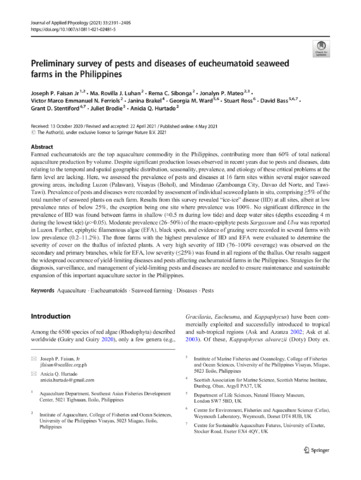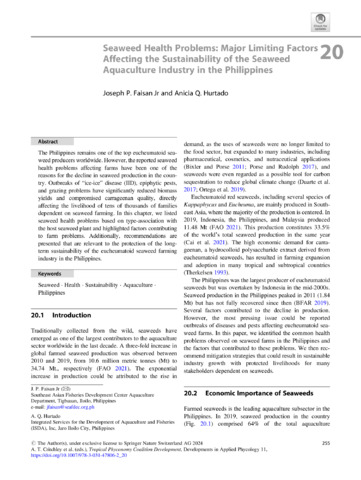Ice-Ice disease: An environmentally and microbiologically driven syndrome in tropical seaweed aquaculture

View/Open
Date
2022-01Author
Page views
1,128Metadata
Show full item recordCited times in Scopus
128 readers on Mendeley
Share
Abstract
Seaweeds account for nearly 30% of global aquaculture production by volume, and their cultivation provides important opportunities for employment and wealth generation, particularly in rural coastal communities. Eucheumatoids (Kappaphycus and Eucheuma spp.) are tropical red algae commercially cultivated as raw material for production of carrageenans, particularly in South-East Asia and the Western Indian Ocean region. Diseases and pests are major limiting factors in eucheumatoid production, particularly a condition known as ‘ice-ice’ disease (IID). IID is characterized by bleaching of the thallus followed by the disintegration of affected tissues, leading to a loss of biomass and reduced carrageenan yield. IID has been associated with unfavourable changes in environmental conditions, particularly an increase in sea water temperature and a decrease in salinity, and infection by opportunistic or pathogenic bacteria. However, given that no single or combined causal agents have been definitely identified, IID may be considered a complex pathobiotic syndrome in which multiple factors contribute to the development of disease signs. Here, we review current knowledge of the abiotic and biotic factors associated with the development of IID, and the strategies employed to mitigate economic losses resulting from disease outbreaks. We discuss syndromic diseases in other marine holobionts, particularly other red algae and corals, in relation to their similarity to IID, and suggest the application of comprehensive and complementary methodologies, including high-throughput sequencing and high-quality microscopy, for enhancing our understanding of the pathological and microbiological processes associated with IID signs.
Suggested Citation
Ward, G., Kambey, C., Faisan, J. P., Jr., Tan, P. L., Daumich, C., Matoju, I., Stentiford, G., Bass, D., Lim, P. E., Brodie, J., & Poong, S. W. (2022). Ice-Ice disease: An environmentally and microbiologically driven syndrome in tropical seaweed aquaculture. Reviews in Aquaculture , 14(1), 414-439. https://doi.org/10.1111/raq.12606
Subject
Taxonomic term
Collections
- AQD Journal Articles [1248]
Related items
Showing items related by title, author, creator and subject.
-
Preliminary survey of pests and diseases of eucheumatoid seaweed farms in the Philippines
Faisan, Joseph P., Jr.; Luhan, Maria Rovilla; Sibonga, Rema; Mateo, Jonalyn; Ferriols, Victor Marco Emmanuel; Brakel, Janina; Ward, Georgia M.; Ross, Stuart; Bass, David; Stentiford, Grant; Brodie, Juliet; Hurtado, Anicia Q. (Springer, 2021-05-04)Farmed eucheumatoids are the top aquaculture commodity in the Philippines, contributing more than 60% of total national aquaculture production by volume. Despite significant production losses observed in recent years due ... -
Seaweed health problems: Major limiting factors affecting the sustainability of the seaweed aquaculture industry in the Philippines
Faisan, Jr., Joseph; Hurtado, Anicia Q. (Springer International Publishing, 2024)The Philippines remains one of the top eucheumatoid seaweed producers worldwide. However, the reported seaweed health problems affecting farms have been one of the reasons for the decline in seaweed production in the ... -
Potentials of Kappaphycus striatum (Schnitz) and Gracilaria heteroclada Zhang (Ad Xia) to control the growth of luminous bacteria Vibrio harveyi
Tendencia, Eleonor; de la Peña, Milagros R. (University of the Philippines Los Baños, 2010)Different aquaculture species such as finfishes and bivalves have been reported to control the luminous bacterial disease of shrimp, usually caused by Vibrio harveyi. The use of seaweeds in shrimp culture system has ...



